High-Fidelity Steady-State and Transient Simulations of an MTR Research Reactor Using Serpent2/Subchanflow
Abstract
:1. Introduction
2. Benchmark Problem
2.1. Steady-State Core Specifications
2.2. Transient Core Specifications
3. Methodology
3.1. The Neutronic Code Serpent 2
3.2. The Thermal–Hydraulic Code Subchanflow
3.3. Coupled Neutronic/Thermal–Hydraulic Calculation Scheme Based on Serprnt 2/Subchanflow
3.4. Serpent Models and Assumptions
- Nuclear data library: ENDF/B-VII.0.
- Interface type 22 is used for the data transfer between Serpent 2 and Subchanflow.
- Axially, each plate is subdivided by 20 axial zones.
- The absorber material is made of AgInCd.
- Criticality calculation is performed with 20 inactive cycles followed by 200 active cycles, each consisting of 150,000 histories.
- Fast Reactivity Insertion Accident (FRIA): neutron population of 8.0 × 105 particles with 200 batches.
- Slow Reactivity Insertion Accident (SRIA): neutron population of 1.6 × 106 particles with 200 batches.
3.5. Subchanflow Model and Assumptions
- A plate-centered model resolving each channel as a subchannel.
- For the heat conduction, each plate is subdivided radially into 3 and 2 cells for fuel and cladding, respectively.
- The Blasius and Colburn correlations are used for the friction factor and the heat transfer coefficient, respectively, based on previous validation work [10].
- In total, 552 plates and channels are considered in the core model.
- Axial discretization of each channel in 20 nodes.
3.6. Convergence Criteria and Computer Environment
4. Results
4.1. Selected Parameters of the Steady-State Simulation
- To find the critical position of the control rods (plates of AgInCd) of the MTR core for full power operation, i.e., to achieve a multiplication equal factor to one ();
- To evaluate the key thermal–hydraulic and neutron physical parameters of the core that correspond to the initial conditions before transient analysis is performed;
- To obtain the precursor and live neutrons sources for the following transient external source simulation.
4.2. Simulation of the RIA Transients
4.2.1. Control Rod Movement Scenarios
4.2.2. Power and Reactivity Evolution for the Fast Reactivity Insertion (FRIA 1.5$/0.5 s)
- Steady-state conditions at cold zero power conditions, i.e., 1 W.
- From the stationary reactor condition, a positive reactivity insertion of 1.5$ during 0.5 s.
- The reactor is shutdown when the trip set point is achieved, i.e., W with a delay time of 25 ms (10$, 0.5 s insertion time).
4.2.3. Power and Reactivity Evolution of the Slow Reactivity Insertion (SRIA 1$/10 s) Scenario
- Steady-state conditions at cold zero power conditions with 1 W power.
- From the stationary reactor condition, a positive reactivity ramp with the insertion of 1$ during 10 s.
- The reactor is shutdown when the set point of 12E6 W is achieved by inserting all control elements (10$, insertion time 0.5 s) with a delay of 25 ms.
5. Summary and Outlook
Author Contributions
Funding
Institutional Review Board Statement
Informed Consent Statement
Data Availability Statement
Acknowledgments
Conflicts of Interest
References
- Chao, J.; Cheung, Y.K.; Olson, A.P. COBRA-3C/RERTR, a Subchannel Code for Research and Test Reactors. Trans. Am. Nucl. Soc. 1980, 34, 892–893. [Google Scholar]
- Ahmed, K. Thermal-Hydraulic Fortran Program for Steady-State Calculations of Plate-Type Fuel Research Reactors. Nucl. Technol. Radiat. Prot. 2008, 23, 19–30. [Google Scholar] [CrossRef]
- Koppers, V.; Koch, M.K. Heuristic Methods in Modelling Research Reactors for Deterministic Safety Analysis. Atw Int. Z. Fuer Kernenerg. 2018, 63, 464–468. [Google Scholar]
- Margulis, M.; Gilad, E. Development and Verification of the Dynamic System Code THERMO-T for Research Reactor Accident Analysis. Nucl. Technol. 2016, 196, 377–395. [Google Scholar] [CrossRef]
- Hermansyah, H.; Kumaraningrum, A.R.; Purba, J.H.; Edison; Yohda, M. Safety Analysis Technique for System with Limited Data: Case Study of the Multipurpose Research Reactor in Indonesia. Energies 2020, 13, 1975. [Google Scholar] [CrossRef] [Green Version]
- Hamidouche, T.; Bousbia-Salah, A.; Si-Ahmed, E.K.; Mokeddem, M.Y.; D’Auria, F. Application of Coupled Code Technique to a Safety Analysis of a Standard MTR Research Reactor. Nucl. Eng. Des. 2009, 239, 2104–2118. [Google Scholar] [CrossRef]
- Labit, J.-M.; Seiler, N.; Clamens, O.; Merle, E. Thermal-Hydraulic Two-Phase Modeling of Reactivity-Initiated Transients with CATHARE2—Application to SPERT-IV Simulation. Nucl. Eng. Des. 2021, 381, 111310. [Google Scholar] [CrossRef]
- Ferraro, D.; Valtavirta, V.; García, M.; Imke, U.; Tuominen, R.; Leppänen, J.; Sanchez-Espinoza, V. OECD/NRC PWR MOX/UO2 Core Transient Benchmark Pin-by-Pin Solutions Using Serpent/SUBCHANFLOW. Ann. Nucl. Energy 2020, 147, 107745. [Google Scholar] [CrossRef]
- Almachi, J.C.; Imke, U.; Sanchez-Espinoza, V.H. Extension of Subchanflow for Thermal Hydraulic Analysis of MTR-Core. In Proceedings of the European Research Reactor Conference, Online, 12–15 October 2020; pp. 1–10. [Google Scholar] [CrossRef]
- Almachi, J.C.; Sánchez-Espinoza, V.; Imke, U. Extension and Validation of the SubChanFlow Code for the Thermo-Hydraulic Analysis of MTR Cores with Plate-Type Fuel Assemblies. Nucl. Eng. Des. 2021, 379, 111221. [Google Scholar] [CrossRef]
- Zhang, H.; Guo, J.; Lu, J.; Li, F.; Xu, Y.; Downar, T.J. An Assessment of Coupling Algorithms in HTR Simulator TINTE. Nucl. Sci. Eng. 2018, 190, 287–309. [Google Scholar] [CrossRef]
- Ferraro, D.; García, M.; Valtavirta, V.; Imke, U.; Tuominen, R.; Leppänen, J.; Sanchez-Espinoza, V. Serpent/SUBCHANFLOW Pin-by-Pin Coupled Transient Calculations for the SPERT-IIIE Hot Full Power Tests. Ann. Nucl. Energy 2020, 142, 107387. [Google Scholar] [CrossRef]
- Ernesto Ferraro, D. Monte Carlo-Based Multi-Physics Analysis for Transients in Light Water Reactors. Ph.D. Thesis, Karlsruher Institut für Technologie (KIT), Karlsruhe, Germany, 2021. [Google Scholar] [CrossRef]
- International Atomic Energy Agency. Research Reactor Core Conversion from the Use of Highly Enriched Uranium Fuels: Guidebook; IAEA: Vienna, Austria, 1980; Volume IAEA-TECDOC-233. [Google Scholar]
- International Atomic Energy Agency. Research Reactor Core Conversion Guidebook; Volume 3: Analytical Verification (Appendices G and H); IAEA: Vienna, Austria, 1992; Volume IAEA-TECDOC-643. [Google Scholar]
- Arkani, M.; Hassanzadeh, M.; Khakshournia, S. Calculation of Six-Group Importance Weighted Delayed Neutron Fractions and Prompt Neutron Lifetime of MTR Research Reactors Based on Monte Carlo Method. Prog. Nucl. Energy 2016, 88, 352–363. [Google Scholar] [CrossRef]
- Margulis, M.; Gilad, E. Monte Carlo and Nodal Neutron Physics Calculations of the IAEA MTR Benchmark Using Serpent/DYN3D Code System. Prog. Nucl. Energy 2016, 88, 118–133. [Google Scholar] [CrossRef]
- Leppänen, J.; Pusa, M.; Viitanen, T.; Valtavirta, V.; Kaltiaisenaho, T. The Serpent Monte Carlo Code: Status, Development and Applications in 2013. Ann. Nucl. Energy 2015, 82, 142–150. [Google Scholar] [CrossRef]
- Leppänen, J.; Viitanen, T.; Valtavirta, V. Multi-Physics Coupling Scheme in the Serpent 2 Monte Carlo Code. In Proceedings of the ANS Annual Winter Meeting 2012, San Diego, CA, USA, 11–15 November 2012; American Nuclear Society (ANS): La Grange Park, IL, USA, 2012; pp. 1165–1168. [Google Scholar]
- Valtavirta, V. Development and Applications of Multi-Physics Capabilities in a Continuous Energy Monte Carlo Neutron Transport Code. Ph.D. Thesis, Aalto University, Espoo, Finland, 2017. [Google Scholar]
- Valtavirta, V. Multi-Physics Interface. Available online: http://serpent.vtt.fi/mediawiki/index.php/Multi-physics_interface (accessed on 19 January 2022).
- Viitanen, T.; Leppänen, J. Explicit Treatment of Thermal Motion in Continuous-Energy Monte Carlo Tracking Routines. Nucl. Sci. Eng. 2012, 171, 165–173. [Google Scholar] [CrossRef]
- Leppänen, J.; Hovi, V.; Ikonen, T.; Kurki, J.; Pusa, M.; Valtavirta, V.; Viitanen, T. The Numerical Multi-Physics Project (NUMPS) at VTT Technical Research Centre of Finland. Ann. Nucl. Energy 2015, 84, 55–62. [Google Scholar] [CrossRef]
- Imke, U.; Sanchez, V.H. Validation of the Subchannel Code SUBCHANFLOW Using the NUPEC PWR Tests (PSBT). Sci. Technol. Nucl. Install. 2012, 2012, 465059. [Google Scholar] [CrossRef]
- Tuominen, R.; Valtavirta, V.; García, M.; Ferraro, D.; Leppänen, J. Effect of Energy Deposition Modelling in Coupled Steady State Monte Carlo Neutronics/Thermal Hydraulics Calculations. International Conference on Physics of Reactors: Transition to a Scalable Nuclear Future, PHYSOR 2020, Proceedings of the EDP Sciences—Web of Conferences. 2020. Available online: https://www.epj-conferences.org/articles/epjconf/abs/2021/01/epjconf_physor2020_06001/epjconf_physor2020_06001.html (accessed on 24 January 2022).
- Valtavirta, V.; Hessan, M.; Leppänen, J. Delayed Neutron Emission Model for Time Dependent Simulations with the Serpent 2 Monte Carlo Code. In PHYSOR 2016: Unifying Theory and Experiments in the 21st Century; American Nuclear Society (ANS): Washington, DC, USA, 2016. [Google Scholar]
- García, M.; Ferraro, D.; Valtavirta, V.; Imke, U.; Tuominen, R.; Sanchez-Espinoza, V.; Mercatali, L. Development of an Object-Oriented Serpent2-SUBCHANFLOW Coupling and Verification with Problem 6 of the VERA Core Physics Benchmark. In International Conference on Mathematics and Computational Methods Applied to Nuclear Science and Engineering, M and C 2019; American Nuclear Society (ANS): Portland, OR, USA, 2019; pp. 1424–1433. [Google Scholar] [CrossRef]
- Ferraro, D.; Garcia, M.; Imke, U.; Valtavirta, V.; Leppänen, J.; Sanchez-Espinoza, V. Serpent/SCF Pin-Level Multiphysics Solutions for the VERA Fuel Assembly Benchmark. Ann. Nucl. Energy 2019, 128, 102–114. [Google Scholar] [CrossRef]
- Hainoun, A.; Ghazi, N.; Mansour Abdul-Moaiz, B. Safety Analysis of the Reference Research Reactor MTR during Reactivity Insertion Accident Using the Code MERSAT. Ann. Nucl. Energy 2010, 37, 853–860. [Google Scholar] [CrossRef]
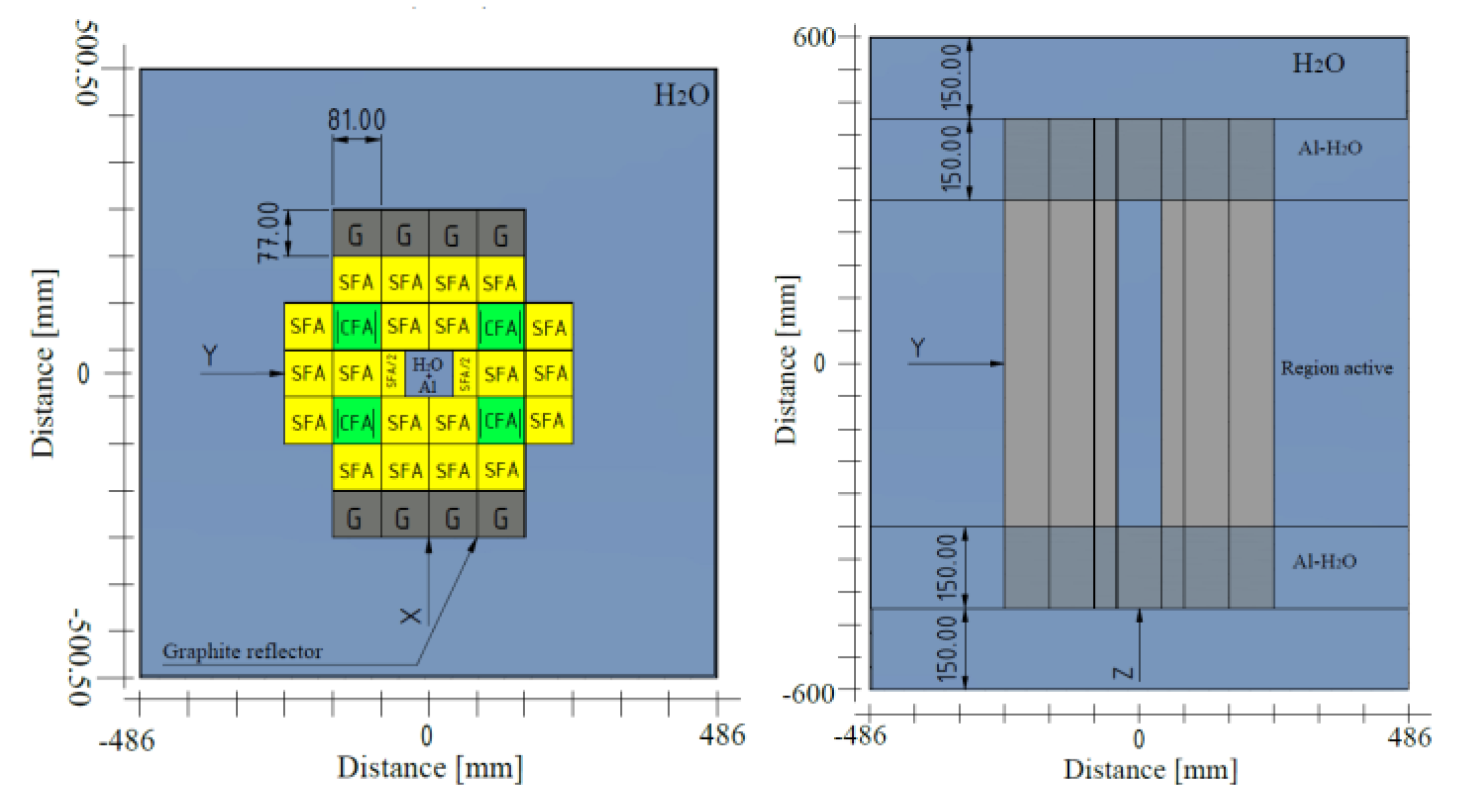
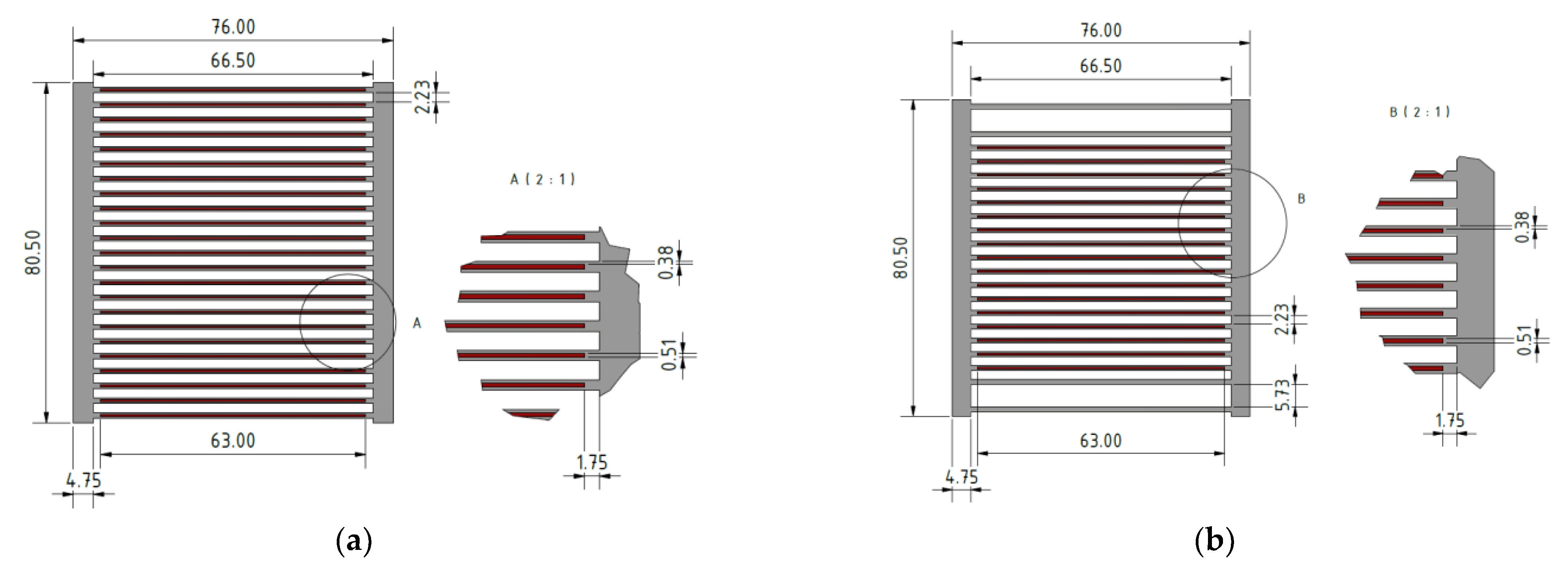
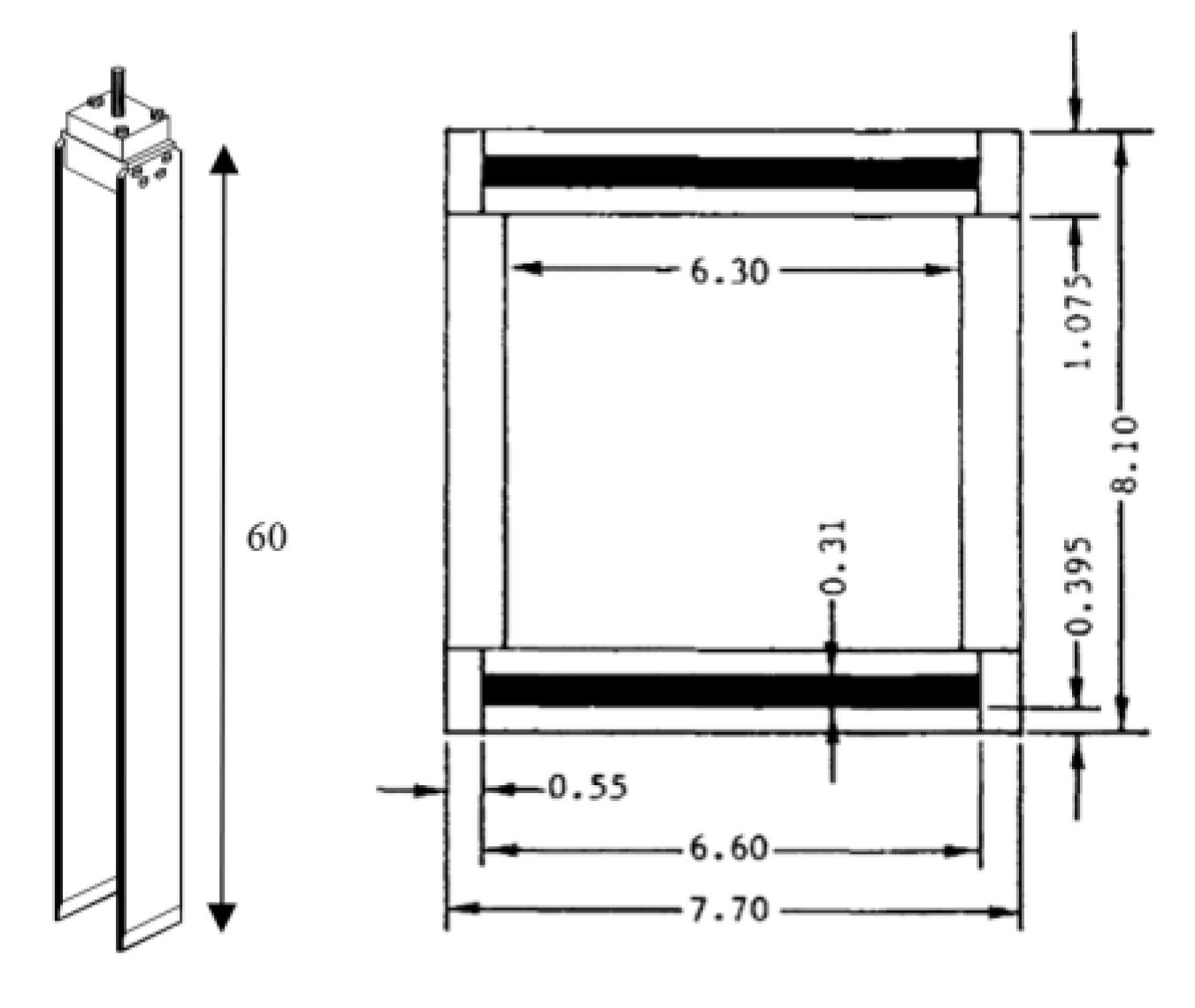
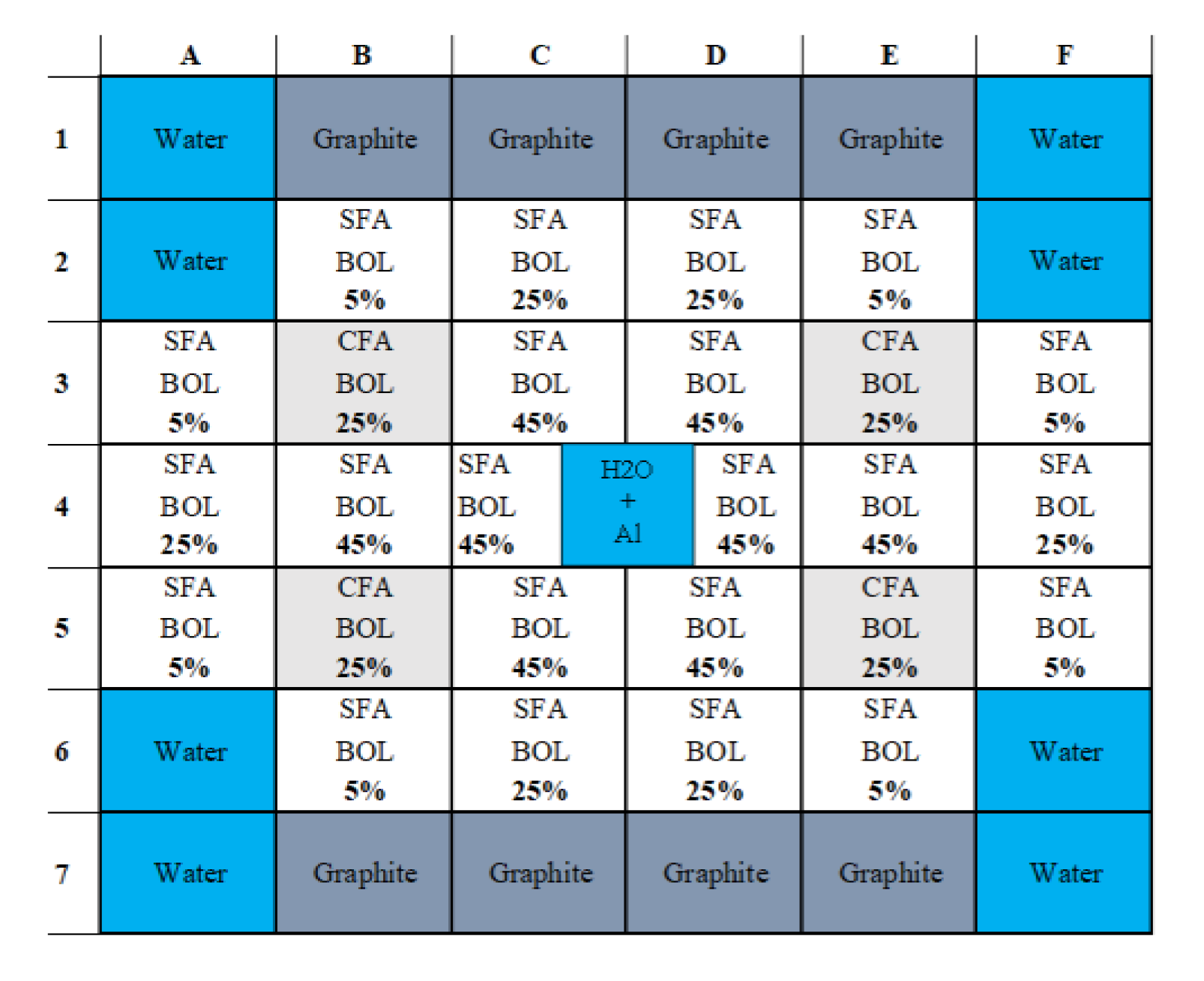
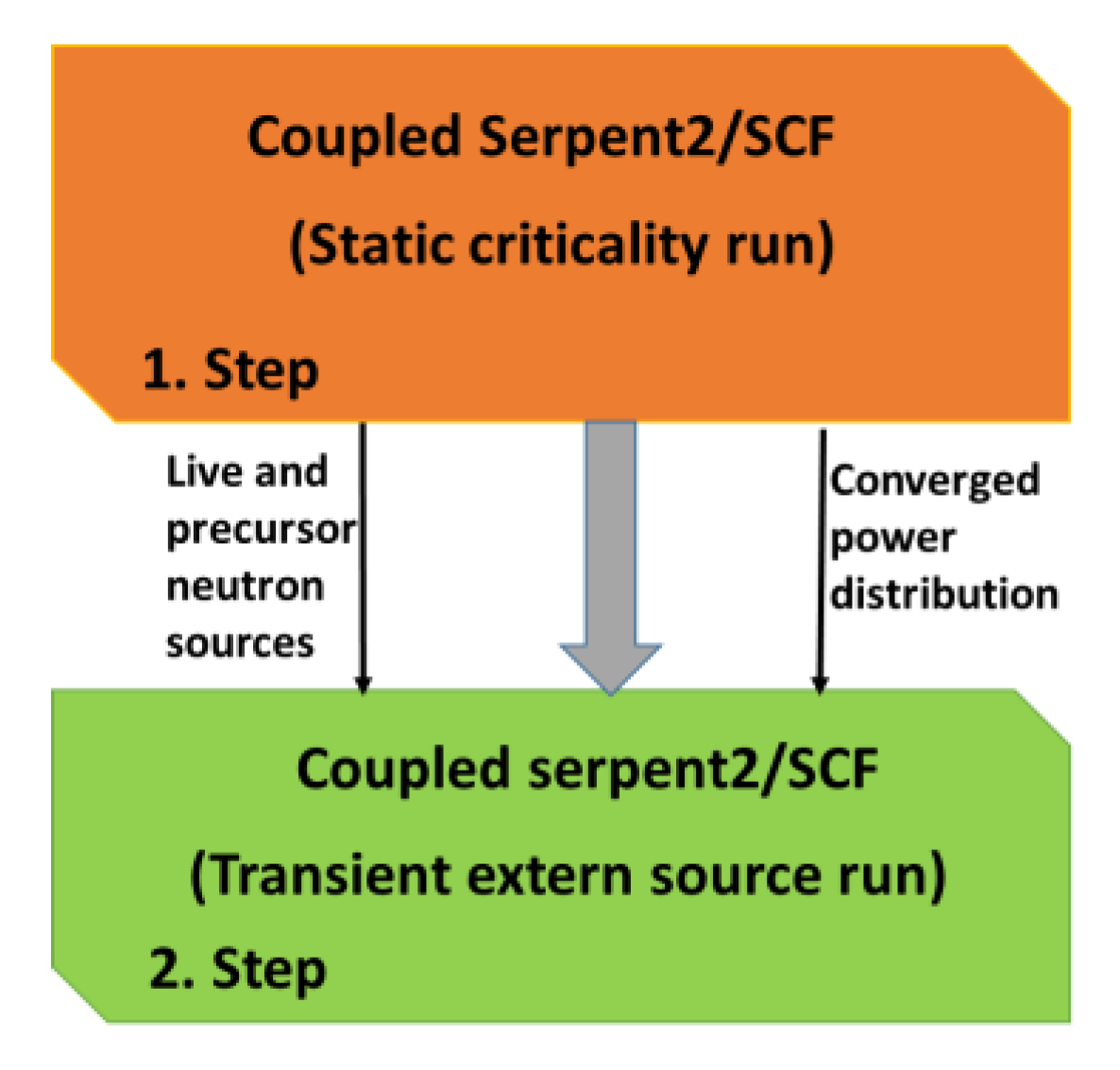
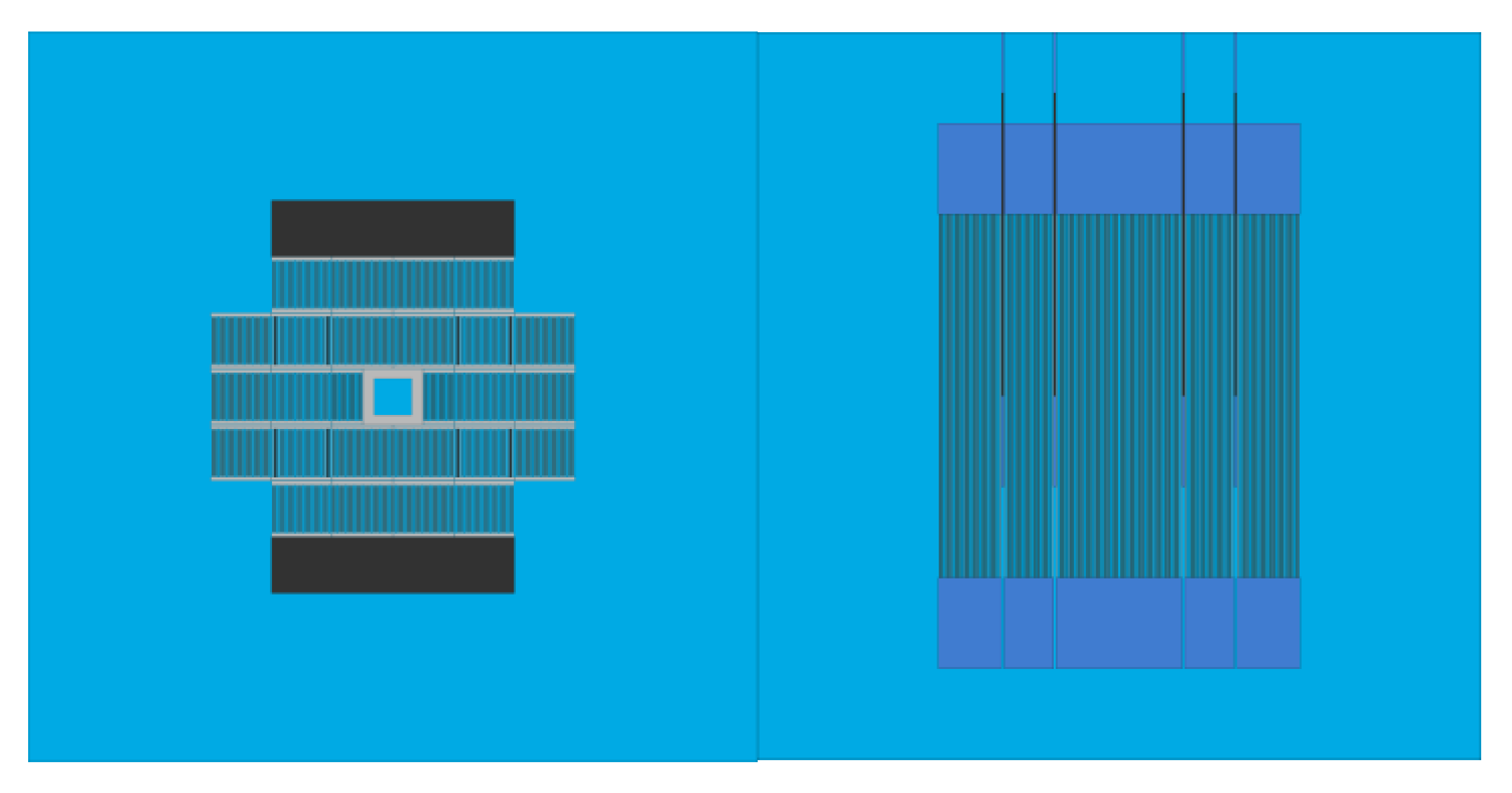


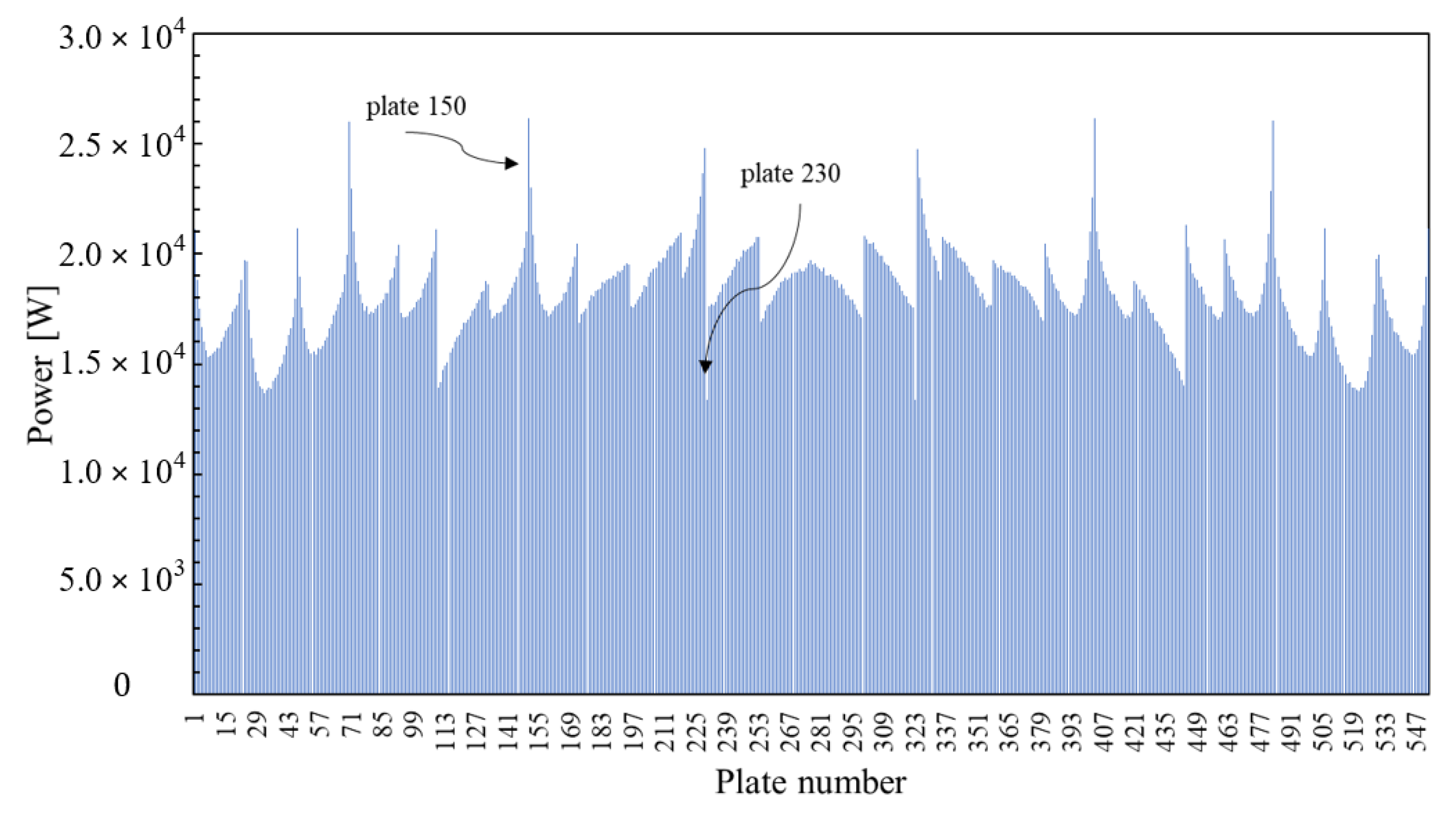


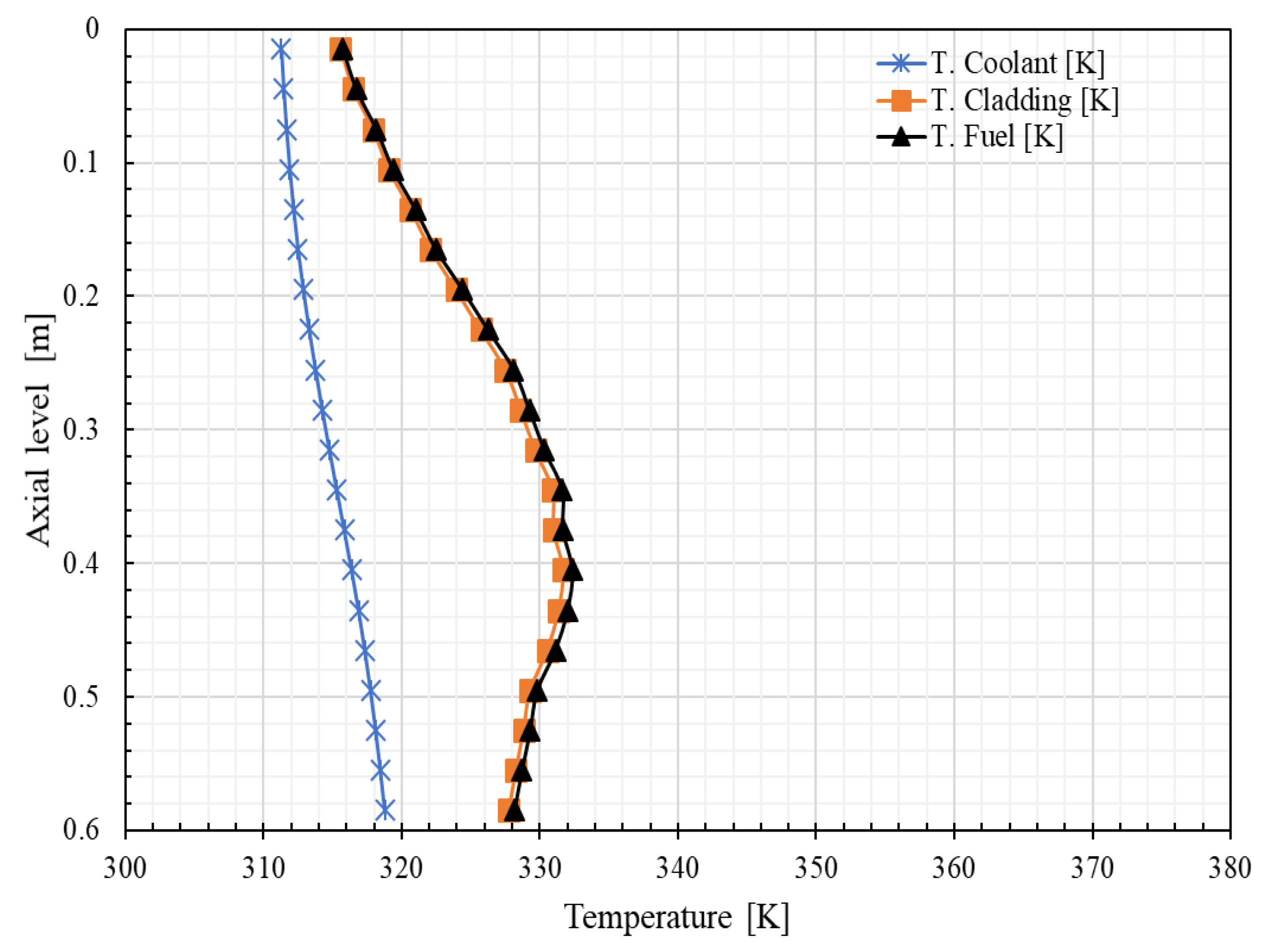


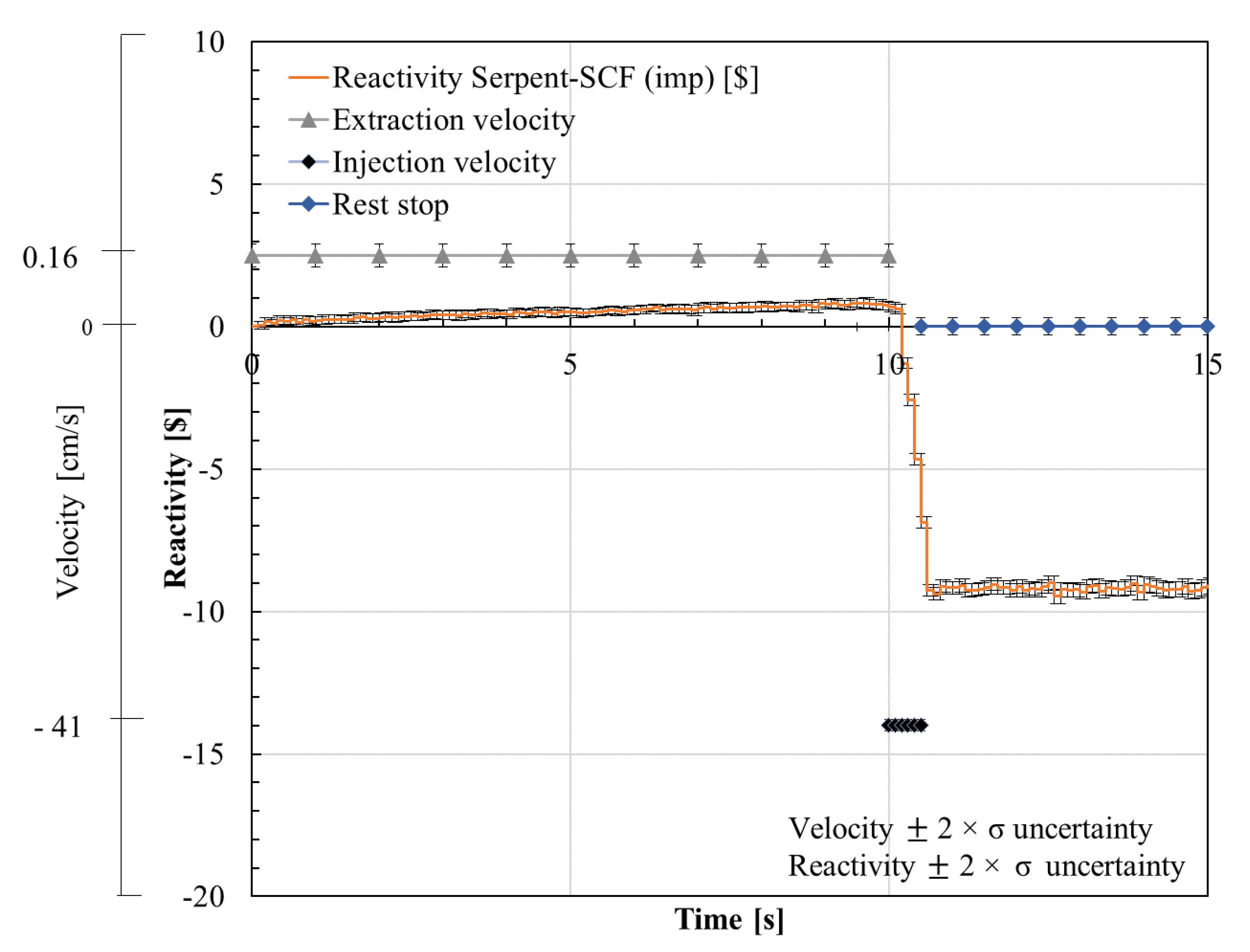
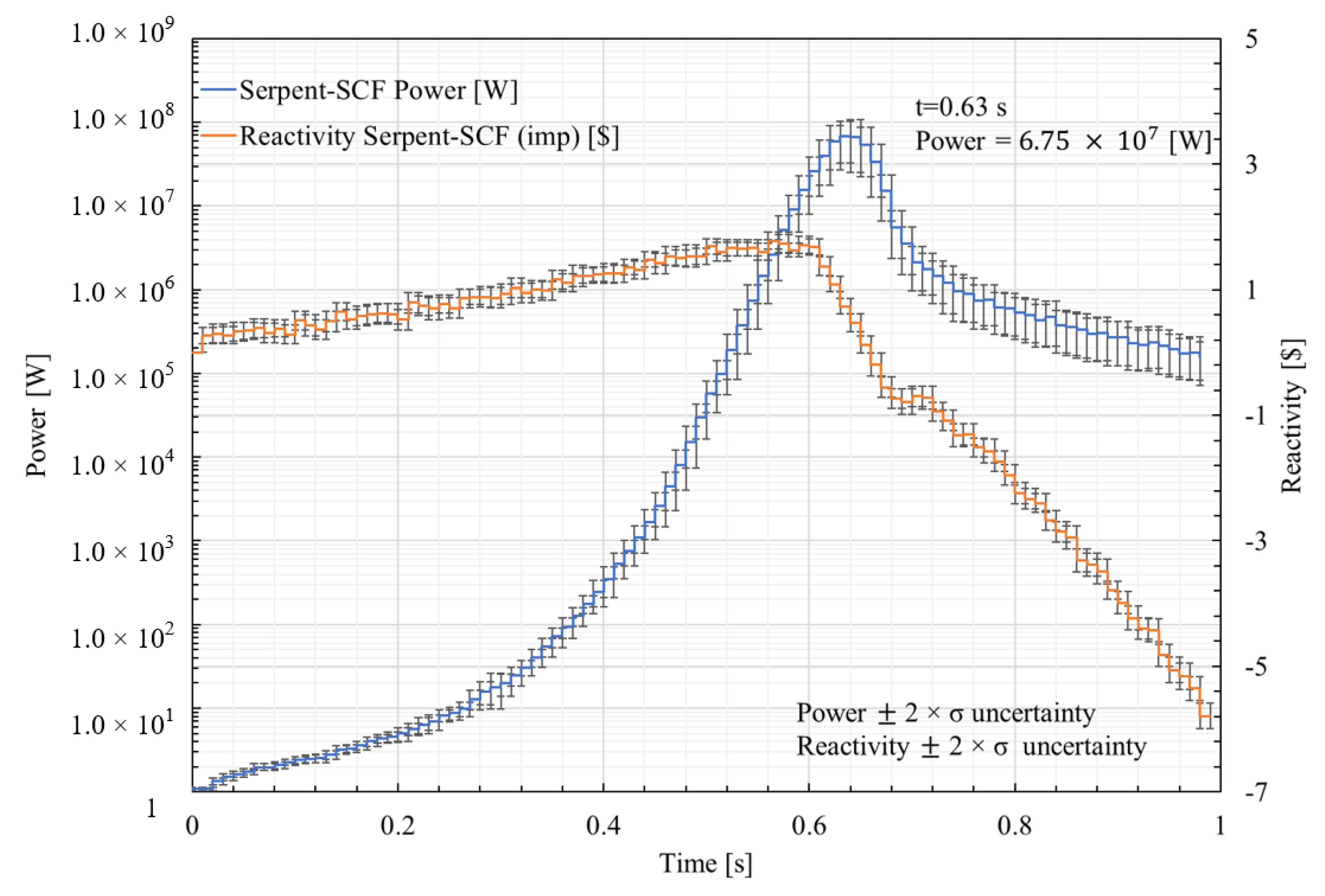
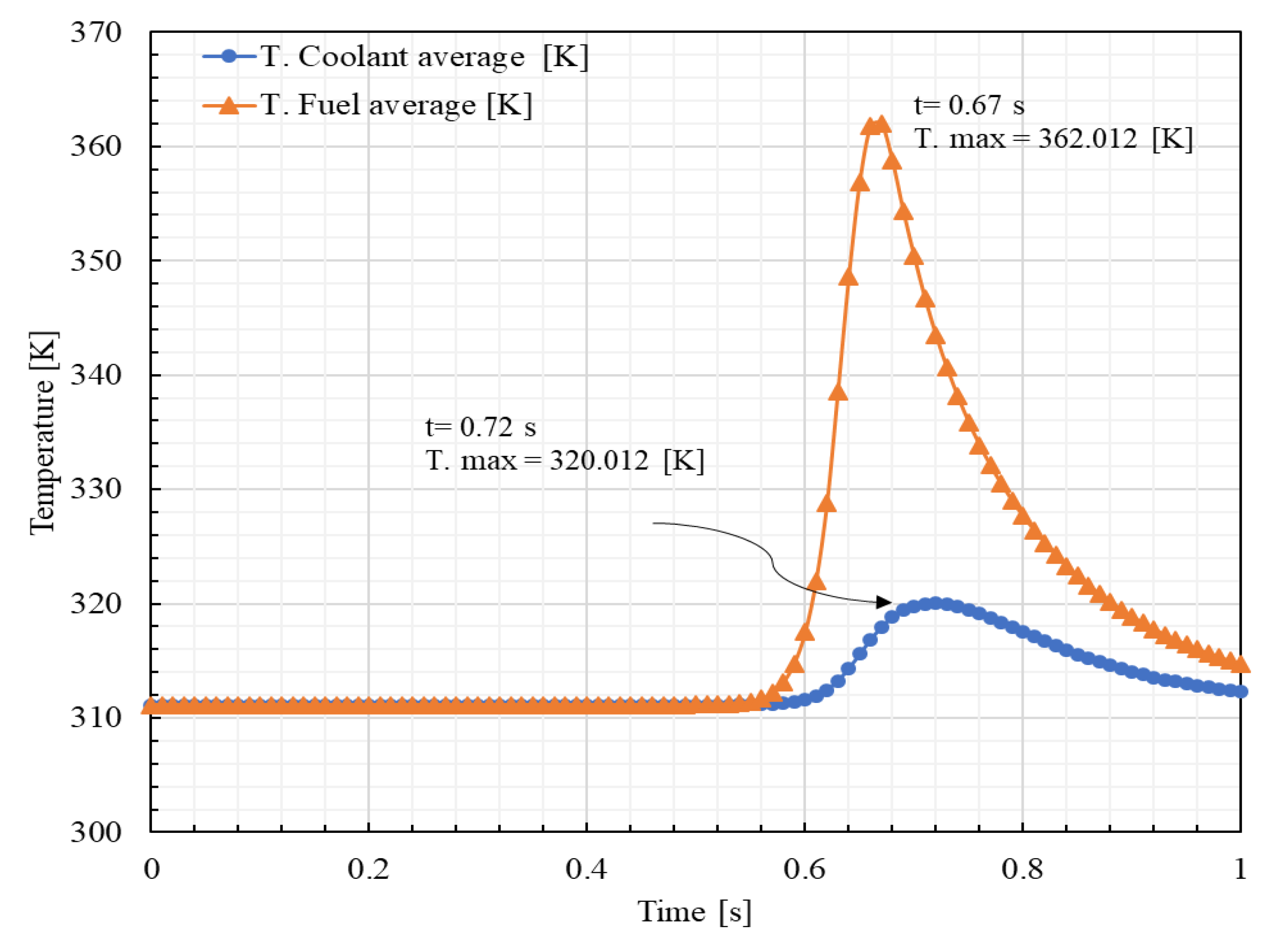
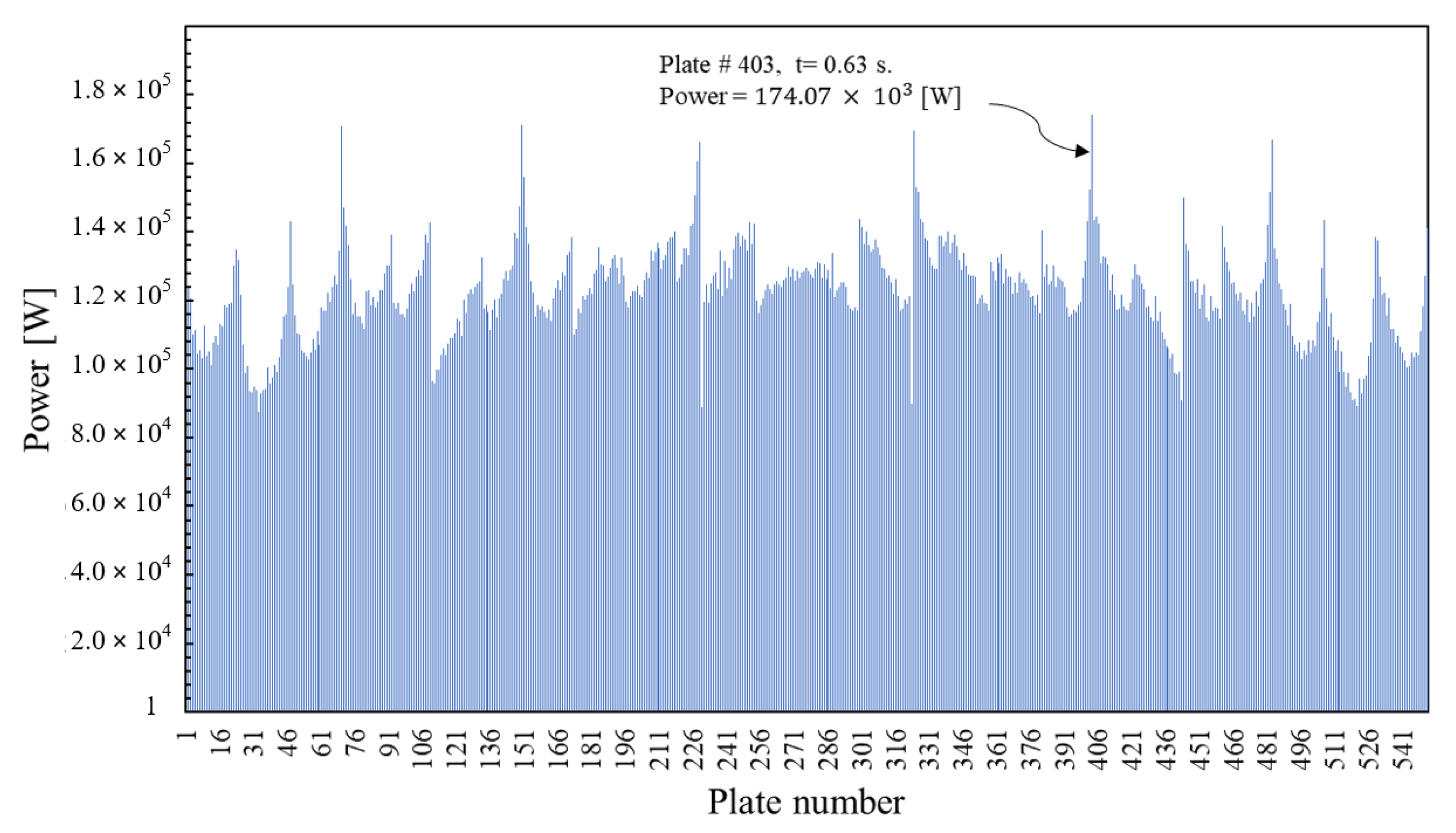
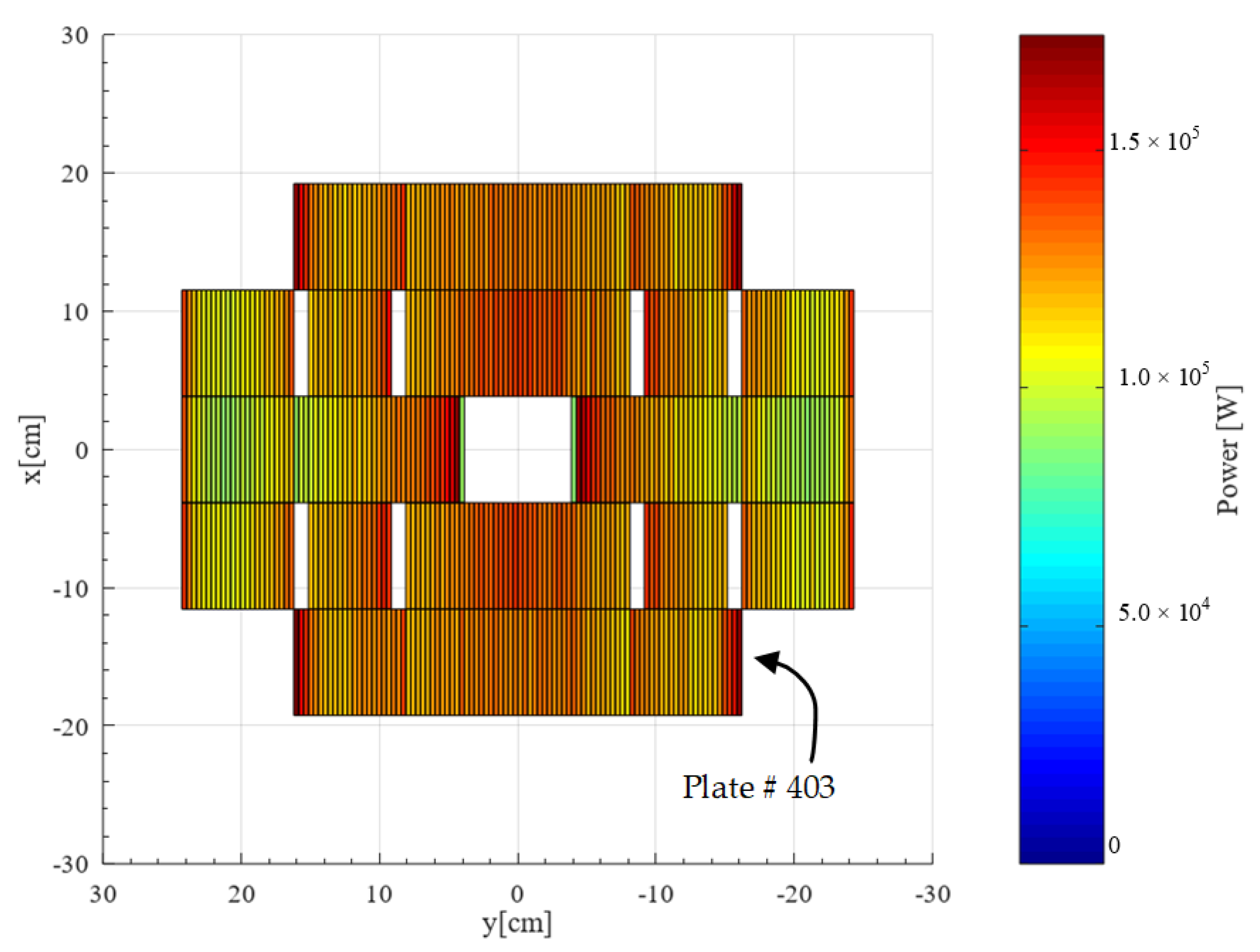
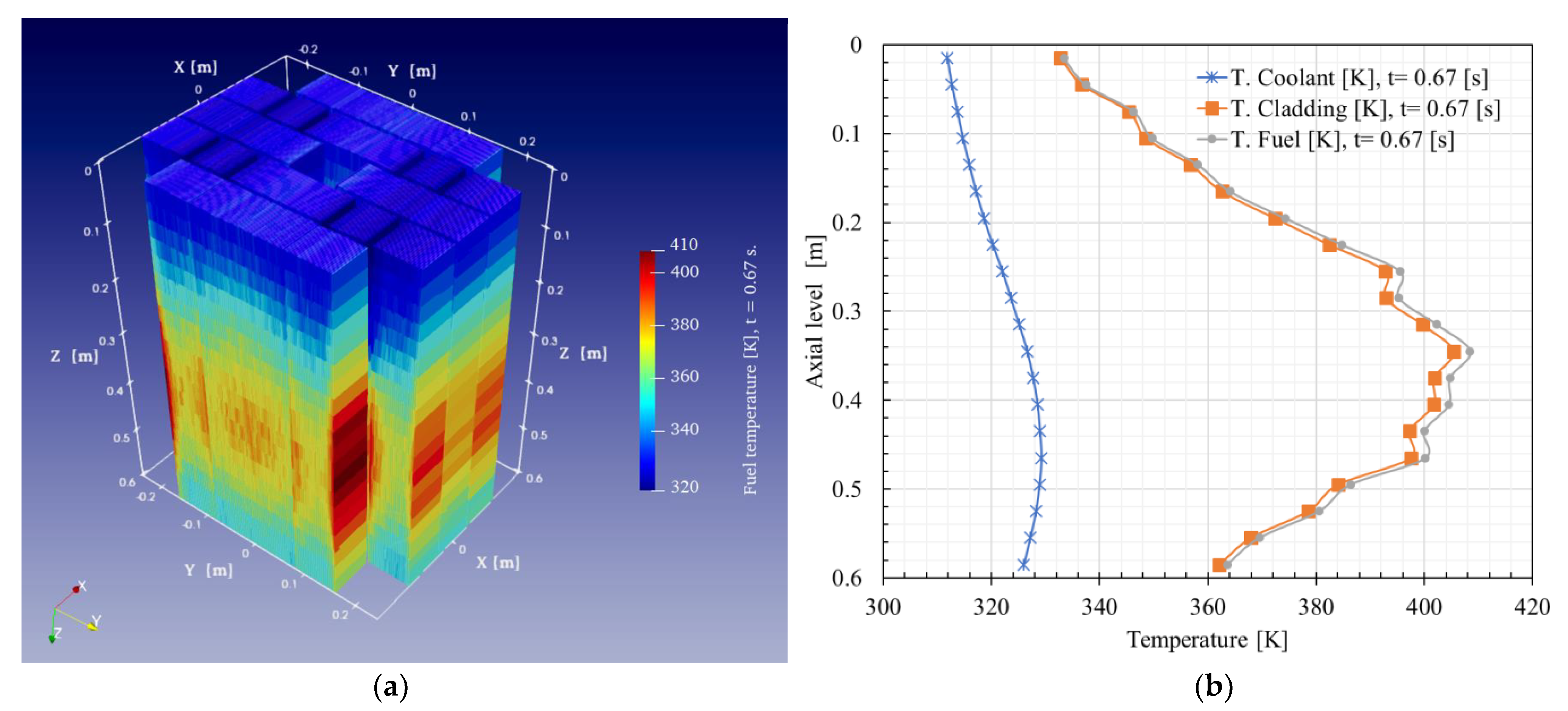
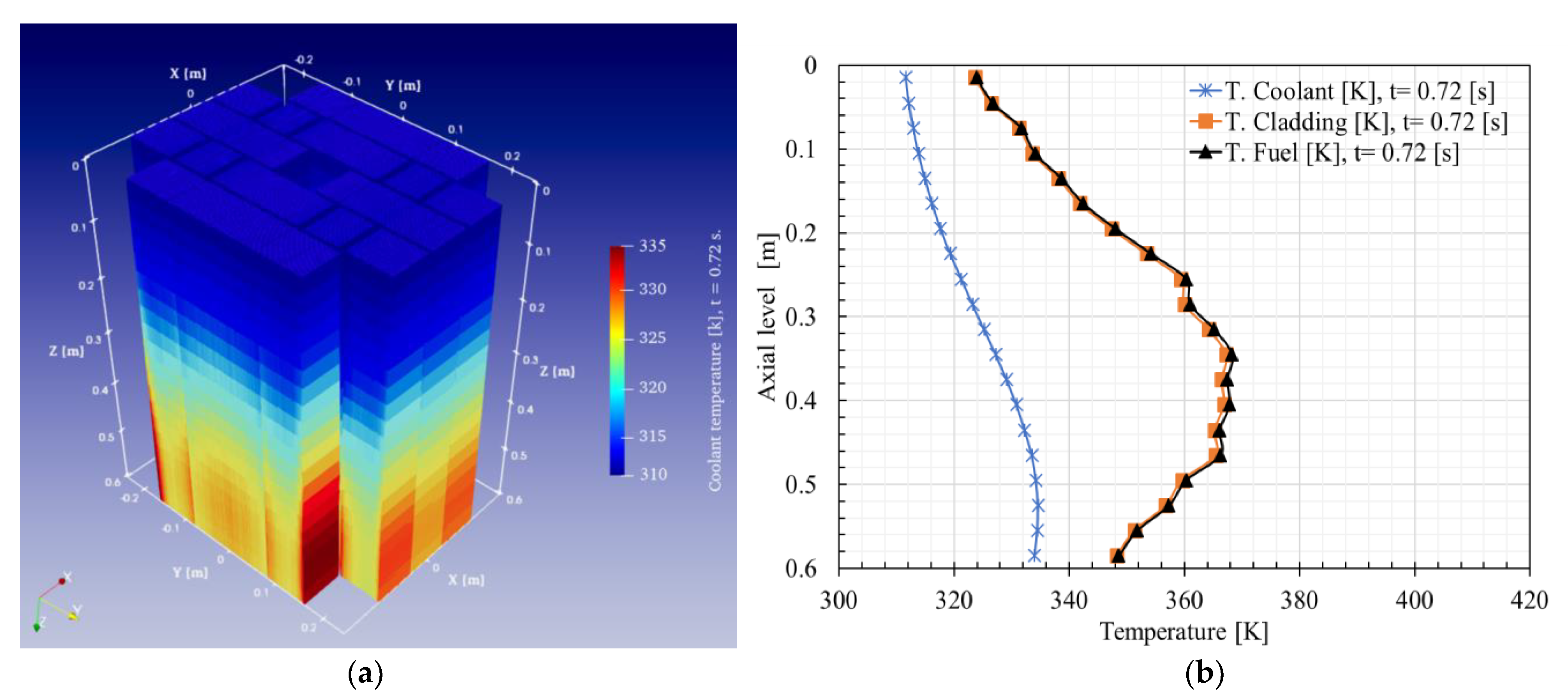
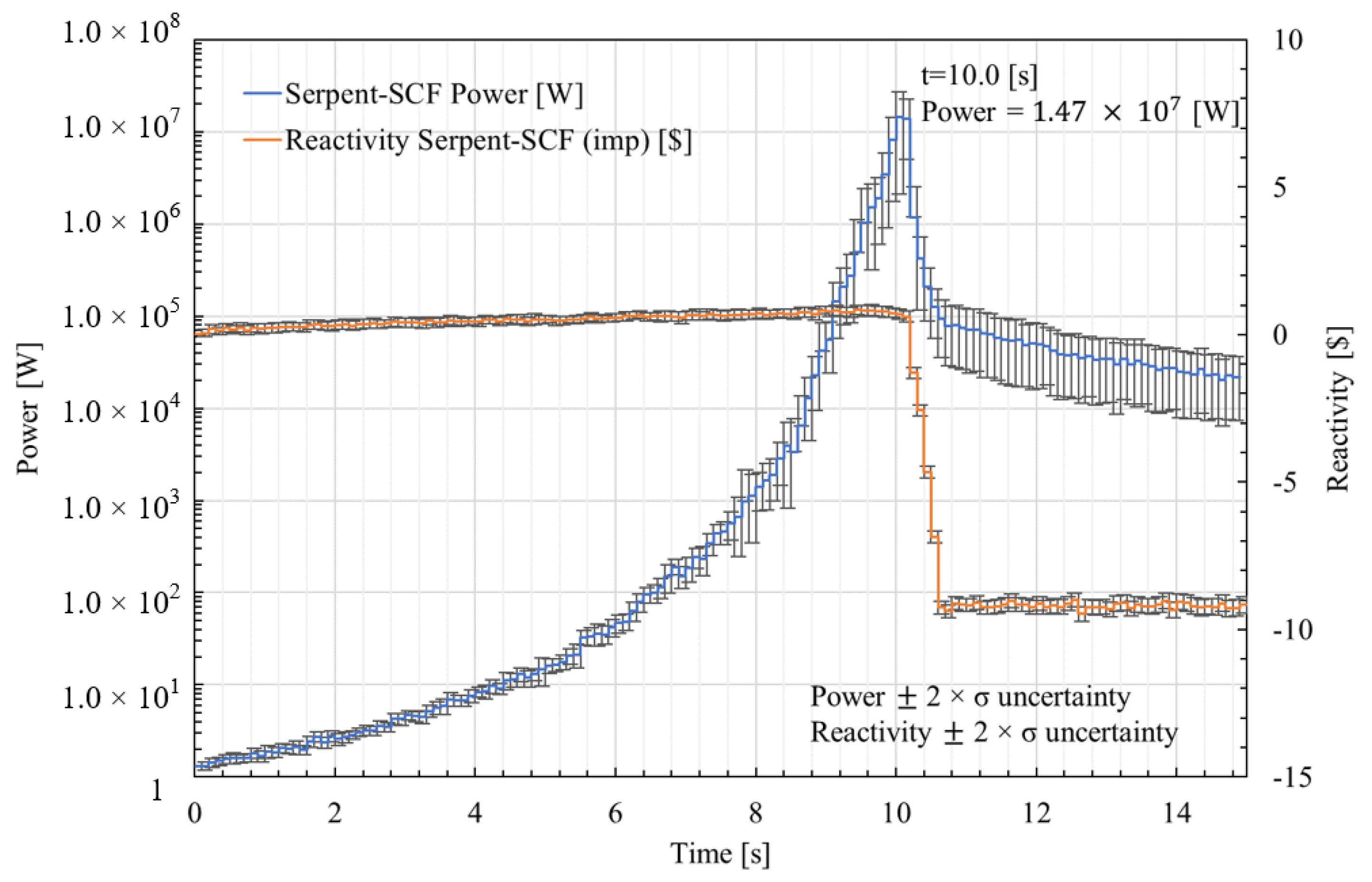
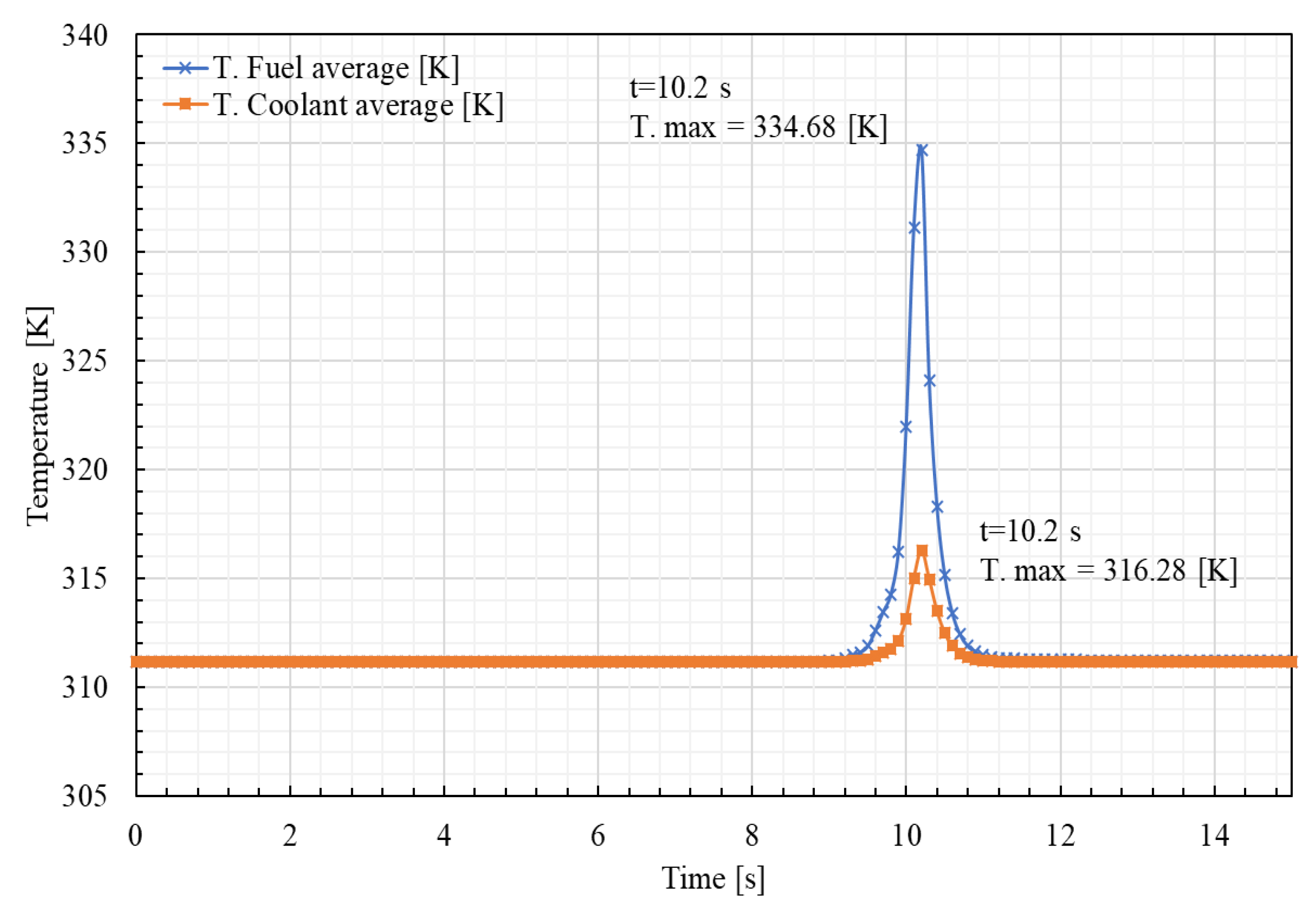
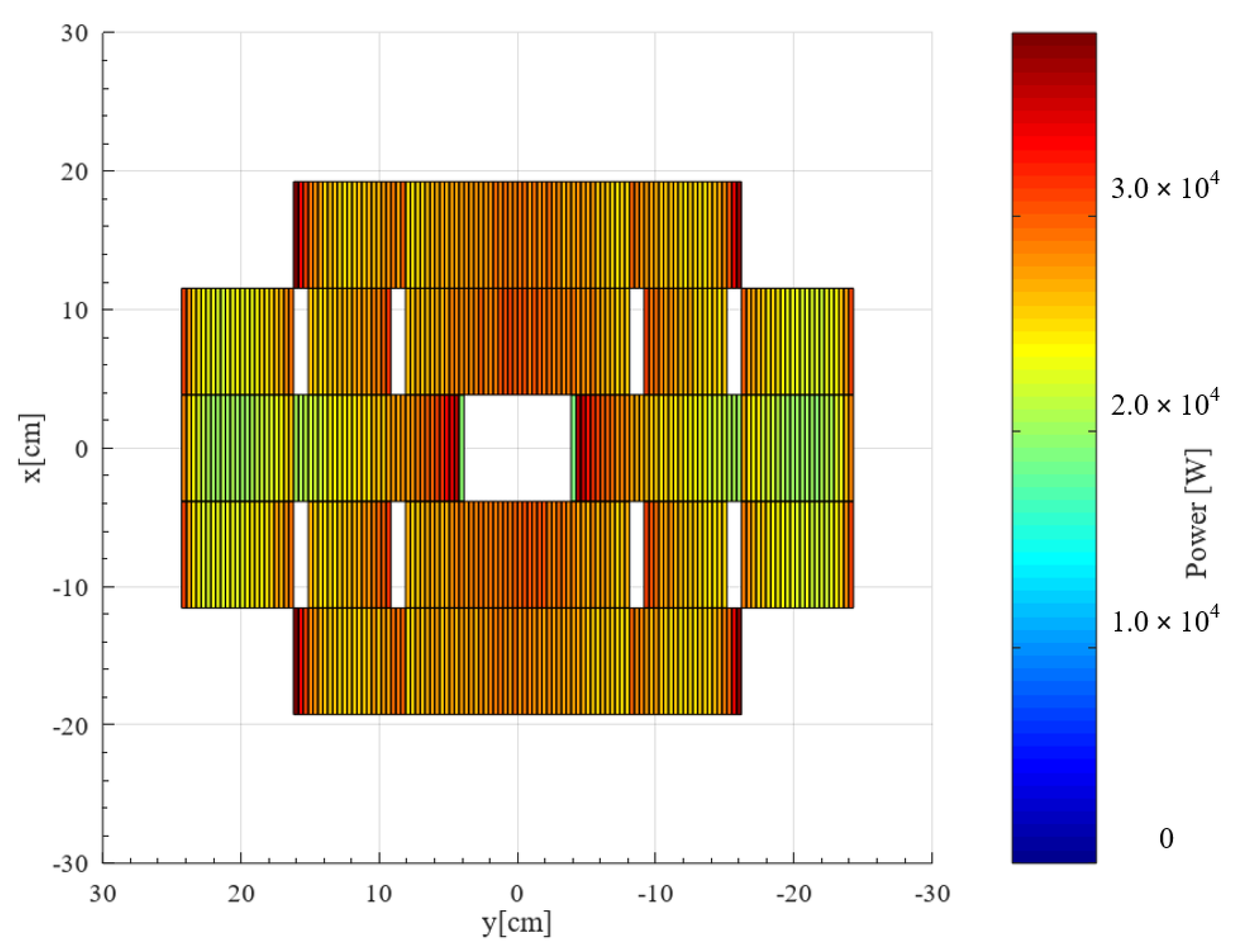
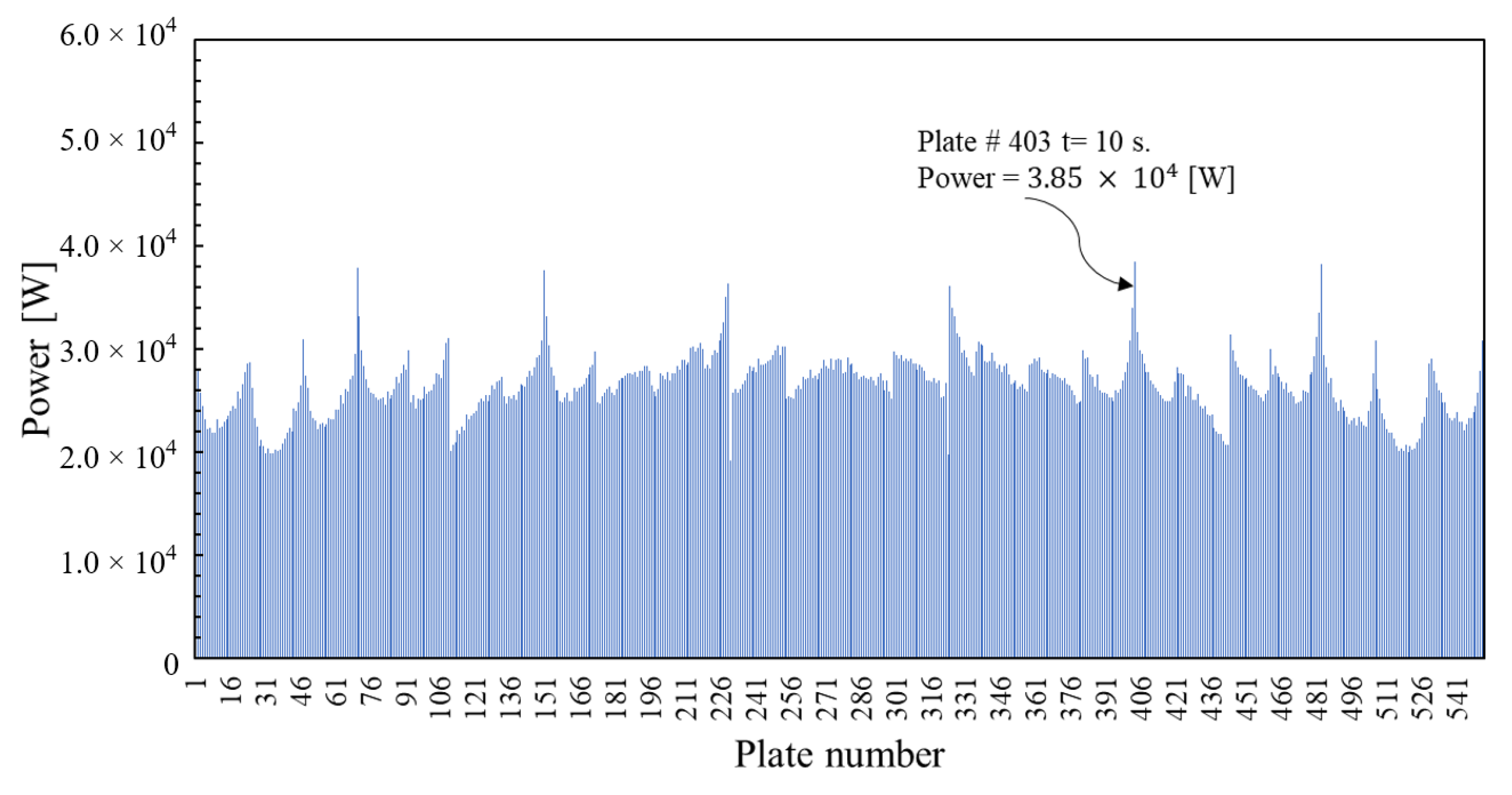

| Parameters | HEU/BOL |
|---|---|
| Material fuel HEU | |
| Total power | 10 MW (steady-state) |
| Coolant temperature inlet | 311 K |
| Pressure at top of the core | 1.7 bar |
| Coolant mass flow rate (downward) | 1000 m3/h |
| Parameters | RIA HEU-BOL |
|---|---|
| Initial power | 1.0 W for both scenarios |
| Rate of external reactivity insertion |
|
| Scram setpoint | 12 MW (120% of nominal power) |
| Delay time before shutdown | 0.025 s for both scenarios |
| Shutdown reactivity insertion | −10$/0.5 s for both scenarios |
| CR Position (cm) | ||
|---|---|---|
| 1 |
Publisher’s Note: MDPI stays neutral with regard to jurisdictional claims in published maps and institutional affiliations. |
© 2022 by the authors. Licensee MDPI, Basel, Switzerland. This article is an open access article distributed under the terms and conditions of the Creative Commons Attribution (CC BY) license (https://creativecommons.org/licenses/by/4.0/).
Share and Cite
Almachi, J.C.; Sánchez-Espinoza, V.H.; Imke, U. High-Fidelity Steady-State and Transient Simulations of an MTR Research Reactor Using Serpent2/Subchanflow. Energies 2022, 15, 1554. https://doi.org/10.3390/en15041554
Almachi JC, Sánchez-Espinoza VH, Imke U. High-Fidelity Steady-State and Transient Simulations of an MTR Research Reactor Using Serpent2/Subchanflow. Energies. 2022; 15(4):1554. https://doi.org/10.3390/en15041554
Chicago/Turabian StyleAlmachi, Juan Carlos, Víctor Hugo Sánchez-Espinoza, and Uwe Imke. 2022. "High-Fidelity Steady-State and Transient Simulations of an MTR Research Reactor Using Serpent2/Subchanflow" Energies 15, no. 4: 1554. https://doi.org/10.3390/en15041554







